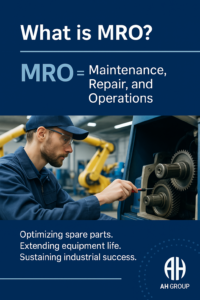
What Is MRO? Understanding the Meaning of Maintenance, Repair, and Operations
In industrial environments, the movement of parts, the hum of machines, and the efficiency of operations often overshadow the behind-the-scenes systems keeping everything running. Yet, within every facility, there’s an essential function that directly influences uptime, safety, and profitability: MRO.
MRO stands for Maintenance, Repair, and Operations – or sometimes, Maintenance, Repair, and Overhaul. While often treated as a support function, MRO plays a strategic role in ensuring operational continuity, cost control, and productivity.
At AH Group, we help global manufacturers optimize their MRO strategies to increase asset lifespan, reduce downtime, and maintain a safer, more efficient work environment.
What Does MRO Actually Mean?
MRO Meaning can be understood through two primary lenses:
- Maintenance, Repair, and Operations refers to the activities and materials used to support day-to-day facility functions and ensure that equipment operates reliably.
- Maintenance, Repair, and Overhaul is more common in sectors like aerospace, involving in-depth inspections and component restoration.
Regardless of the term used, MRO includes all indirect purchases – things that don’t go into the final product but are essential to keep production running. These costs fall under indirect spending, contrasting with direct materials like raw inputs.
A well-managed MRO program contributes directly to operational predictability, safety, and cost-efficiency.
What Falls Under MRO?
MRO spans a wide and diverse range of categories, including:

- Spare parts & tooling for machinery and production lines (e.g., bearings, seals, motors, lubricants)
- Preventive maintenance supplies, including filters, belts, and sensors
- Janitorial and facility supplies such as industrial cleaners, lighting, HVAC maintenance items, and pest control products
- Safety equipment, including PPE like gloves, respirators, masks, and hard hats
- Office and break room supplies, such as paper products, pens, cleaning wipes, and light tools
- Material handling equipment maintenance – including forklifts, conveyors, and storage systems
In addition to material categories, MRO supports three key maintenance strategies:
- Preventive maintenance (routine upkeep)
- Predictive maintenance (data-driven forecasting)
- Corrective maintenance (repairs after failure)
Each component contributes to workflow optimization and reduces the risk of unplanned downtime.
Challenges in MRO Management
Despite its importance, MRO is often under-managed. Common issues include:
- Decentralized procurement, which leads to inconsistent spending and lack of oversight
- Limited visibility into stock levels, causing overstocking or last-minute reordering
- Short-term cost decisions, such as switching vendors frequently and ignoring Total Cost of Ownership (TCO)
- Reactive maintenance practices that increase costs and reduce equipment reliability
The result is redundant spending, missed savings opportunities, and wasted time for maintenance personnel searching for parts.
Optimizing MRO Through Modern Solutions
Strategic MRO management is essential for competitive industrial operations. At AH Group, we recommend:
- Centralized procurement supported by software solutions that track spending and usage
- Vendor-managed inventory (VMI) programs to maintain optimal stock levels
- Enterprise Asset Management (EAM) and CMMS platforms to streamline maintenance scheduling and asset tracking
- Predictive maintenance powered by data-driven analytics to anticipate failures before they occur
- Exploration of emerging technologies such as digital twins, 3D printing, AR/VR, and blockchain for advanced control and flexibility
These tools support data-driven decisions, reduce waste, and improve uptime across the facility.
MRO as a Strategic Lever for Industrial Success
MRO is more than maintenance – it’s a driver of operational success. From extending asset life to reducing risk and improving productivity, a thoughtful MRO strategy impacts every corner of your business.
At AH Group, we support clients in moving MRO from an afterthought to a strategic function through expert consultation, vendor partnerships, and global repair networks. If your business is looking to reduce downtime, enhance inventory control, or improve vendor performance, our team is ready to help.
Contact AH Group today to learn how we can help you build a more resilient, cost-effective, and future-ready MRO repair program.